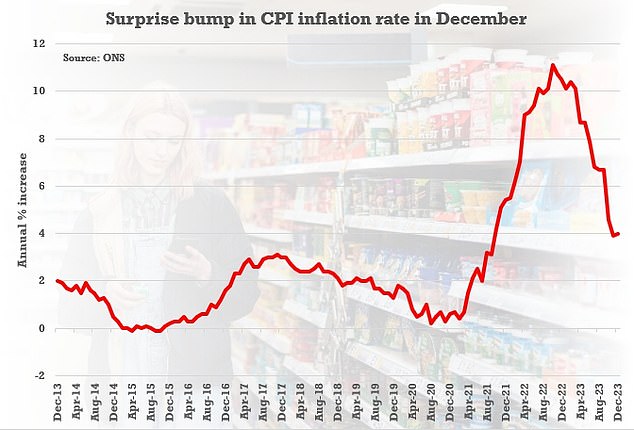
There is no cause for alarm. The small uptick in prices to 4 per cent in the year to December does not mean that the cost-of-living crisis is back.
On the contrary, the trend is towards lower inflation and there has been enormous progress since the key consumer prices index hit a peak of 11.1 per cent in October 2022.
The danger is that, as a result of this minor increase, interest-rate setters at the Bank of England – already bruised by having let inflation get so out of hand in the first place – will delay the hoped-for cut in the official bank rate from its current 5.25 per cent. The markets have been betting on a reduction as soon as May but that could now be put back.
The slight rise in inflation from 3.9 per cent in November to 4 per cent, which is still twice the Bank of England’s target, is largely down to exceptional factors – notably an increase in tobacco duty. That should not have much of an impact on the shopping baskets of most people.


Nevertheless, there could be a further rise in the index this month as a result of a 5 per cent increase in the energy price cap.
After that, barring unexpected accidents, there is little reason that the consumer prices index should not hit the 2 per cent target by summer. One firm of City analysts, ING, is even forecasting that the target could be reached as soon as April.
Lower inflation and lower interest charges on public borrowing could now provide Chancellor Jeremy Hunt with the financial headroom to deliver some eye-catching tax cuts which are seen as the best way of reversing the Tories’ lamentable political polling.
Of course, events may intervene. The major risk to global prices at present is the relentless attacks by Iran-supported Houthi rebels on ships off the coast of Yemen in the Red Sea. This is pushing up the cost of shipping goods from Asia to Western European markets, as goods are diverted away from the Houthi missiles through the Cape of Good Hope and around Africa.
The uncertainty this has caused has also increased the price of crude oil on international markets, which rose above $80 a barrel this week. It is already affecting the price of fuel at the pumps.
However, there are no real energy-supply shortages, as was the case when Russia invaded Ukraine in February 2022, and oil prices are showing signs of drifting down again amid weakness in the Chinese economy.
Until now, Britain’s inflation rate has been stubbornly higher than those of the US and Europe because of wage costs, as public-sector unions demand higher pay and employers feel pushed to increase workers’ earnings.
But earlier this week, the Office for National Statistics reported that annual growth in wages is, at 6.5 per cent, well off its highest level and that the jobs market is softening.
Andrew Bailey, Governor of the Bank of England, has been particularly concerned that Britain might experience a wage price spiral, but that concern is now much less evident.


The rise in tobacco duty has contributed to the uptick in inflation, which has risen from 3.9 per cent in November to 4 per cent
There are also signs that the cost of services – the largest sector of the UK economy, which covers everything from haircuts to computing and financial advice – has steadied. The latest data shows only the slightest uptick in the cost of services, from 6.3 per cent in November to 6.4 per cent last month. Even more encouraging, the price of non-industrial goods fell from 3.3 to 3.1 per cent.
There’s good news, too, on the cost of raw materials used by business, which is continuing on a downward path – although the Red Sea crisis could change this.
The bottom line for most Britons is that wages are more than outpacing inflation and consumer prices and interest rates should fall as the year progresses. Competition among mortgage lenders already has led to five-year fixed-rate loans drop below 4 per cent.
Barring any incidents, the UK bogey of inflation and devastating mortgage costs is, at least for the foreseeable future, a thing of the past.






